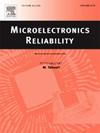基于激光激励动态分析的CMOS差分电路软故障定位
IF 1.9
4区 工程技术
Q3 ENGINEERING, ELECTRICAL & ELECTRONIC
引用次数: 0
摘要
随着半导体工艺的快速发展,器件几何尺寸的小型化使得软故障的发生越来越频繁。虽然数字电路的软故障定位技术已经发展起来,但其在模拟电路中的应用仍然有限。本文提出了一种基于激光刺激动态分析(DALS)技术的CMOS差分电路软故障定位方法。首先建立了差分电路软故障定位的理论模型,然后在台积电130BCD工艺的参考样品上进行了DALS实验,验证了其可行性。此外,还详细研究了激光扫描功率对MOS晶体管特性灵敏度的影响。最后,选取采用相同CMOS工艺制作的两个实际案例进行软故障定位。成功定位出故障的MOS晶体管,验证了DALS技术在CMOS差分电路软故障定位中的有效性。本文章由计算机程序翻译,如有差异,请以英文原文为准。
Soft fault localization on CMOS differential circuit using dynamic analysis by laser stimulation
With the rapid development of semiconductor process, the smaller device geometries make the occurrence of soft fault become more frequent. Although the soft fault localization techniques for digital circuit have been developed, their applications in analogue circuit are limited. In this work a soft fault localization methodology is proposed for CMOS differential circuits based on Dynamic Analysis by Laser Stimulation (DALS) technique. Firstly, the theoretical model for soft fault localization of differential circuit is established, and then its feasibility is verified by DALS experiment on the reference samples fabricated in TSMC 130BCD process. Moreover, the effects of laser scanning power on the sensitivity of MOS transistors' characteristics are investigated in detail. Finally, two real cases fabricated in the same CMOS process are selected to perform the soft fault localization. The failed MOS transistor is successfully located, demonstrating the effectiveness of DALS technique in soft fault localization of CMOS differential circuit.
求助全文
通过发布文献求助,成功后即可免费获取论文全文。
去求助
来源期刊

Microelectronics Reliability
工程技术-工程:电子与电气
CiteScore
3.30
自引率
12.50%
发文量
342
审稿时长
68 days
期刊介绍:
Microelectronics Reliability, is dedicated to disseminating the latest research results and related information on the reliability of microelectronic devices, circuits and systems, from materials, process and manufacturing, to design, testing and operation. The coverage of the journal includes the following topics: measurement, understanding and analysis; evaluation and prediction; modelling and simulation; methodologies and mitigation. Papers which combine reliability with other important areas of microelectronics engineering, such as design, fabrication, integration, testing, and field operation will also be welcome, and practical papers reporting case studies in the field and specific application domains are particularly encouraged.
Most accepted papers will be published as Research Papers, describing significant advances and completed work. Papers reviewing important developing topics of general interest may be accepted for publication as Review Papers. Urgent communications of a more preliminary nature and short reports on completed practical work of current interest may be considered for publication as Research Notes. All contributions are subject to peer review by leading experts in the field.
 求助内容:
求助内容: 应助结果提醒方式:
应助结果提醒方式:


